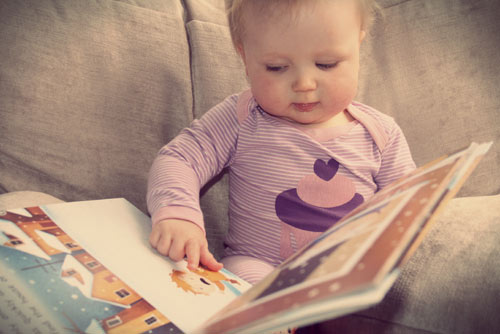紐約大學(xué)的一項新研究表明,教嬰兒閱讀的光盤、閃卡(抽認(rèn)卡)和書等產(chǎn)品不能幫助提高嬰兒的閱讀能力。
這項研究發(fā)表在《教育心理》雜志上,研究對象是117名9到18個月的嬰兒,他們被分成實驗組和對照組。
研究員發(fā)給實驗組嬰兒的父母們一個針對嬰兒的多媒體產(chǎn)品,其中包括光盤、帶有單詞和圖片的閃卡和點讀書,在接下來的七個月的時間里,他們要使用這個產(chǎn)品;而研究員沒有給對照組的嬰兒任何資料。
研究員們通過觀察孩子們是否能辨認(rèn)字母、讀音、單詞,能否辨認(rèn)和理解單詞來測試孩子們的語言能力。
實驗結(jié)果表明,在13到14個評估中,實驗組的嬰兒和對照組的嬰兒沒有區(qū)別。唯一的區(qū)別就是實驗組嬰兒的家長認(rèn)為自己的孩子學(xué)了新單詞。

Despite all the DVDs, flashcards, and books designed to teach babies to read, these products do not help infants develop reading skills, according to a new study by researchers at New York University’s Steinhardt School of Culture, Education, and Human Development.
“While we cannot say with full assurance that infants at this age cannot learn printed words, our results make clear they did not learn printed words from the baby media product that was tested,” said senior author Susan Neuman, professor in NYU Steinhardt’s Department of Teaching and Learning.
Parents, however, seemed to put confidence in these products. In exit interviews, parents reported that their babies were learning to read from these products and that their children had benefited in vocabulary development.
“It’s clear that parents have great confidence in the impact of these products on their children,” Neuman explains. “However, our study indicates this sentiment is misplaced.”
The study, published in the Journal of Educational Psychology, involved 117 infants, ages nine to 18 months, who were randomly assigned to treatment and control groups. Babies in the treatment group received a baby media product, which included DVDs, word and picture flashcards, and flip books for parents to use over a seven-month period; babies in the control group did not receive any materials.
During a seven month period, the researchers conducted one home visit, four laboratory visits, and took monthly assessments of the babies’ language development.
In the laboratory, the researchers tested the babies’ skills by seeing if they could recognize letter names, letter sounds, vocabulary, words identified on sight, and comprehension. They did this by using a combination of eye-tracking devices and standardized tests to study outcomes at each phase of development.
Using state-of-the art eye-tracking technology, which detects even the slightest eye movements, the researchers could closely monitor how the infants shifted their gaze and their attention from one location to another when shown specific words and phrases.
The results showed no differences between the babies exposed to the reading products and the control group on 13 of the 14 assessments. The only assessment that showed a difference was parents’ beliefs that their baby was learning new words.
(來源:中國日報網(wǎng)愛新聞iNews 編輯:丹妮)
